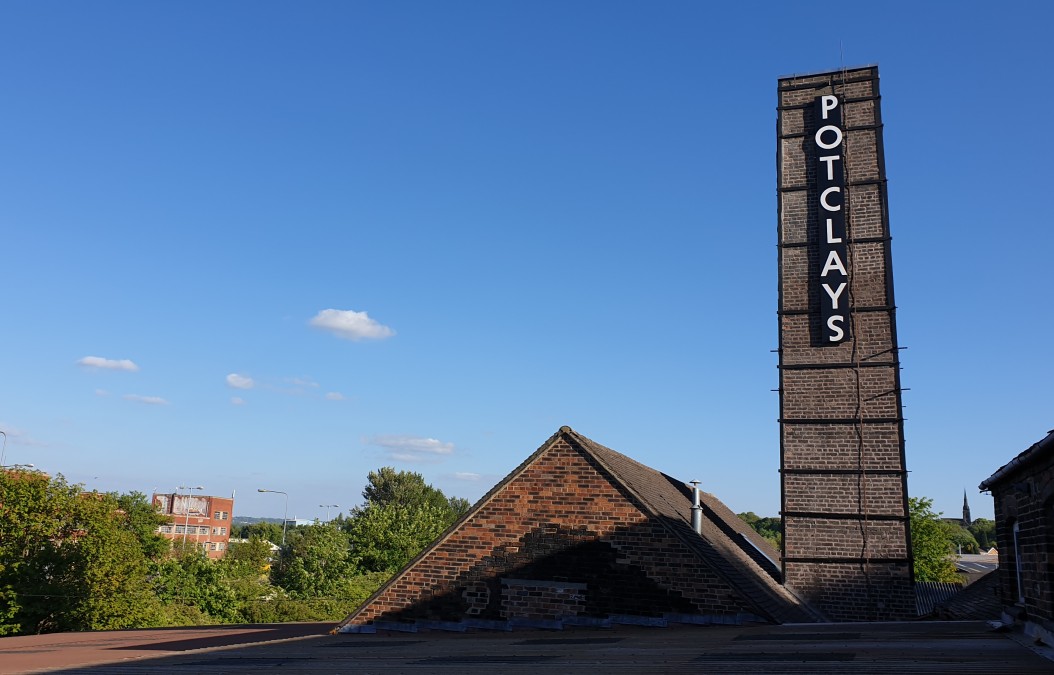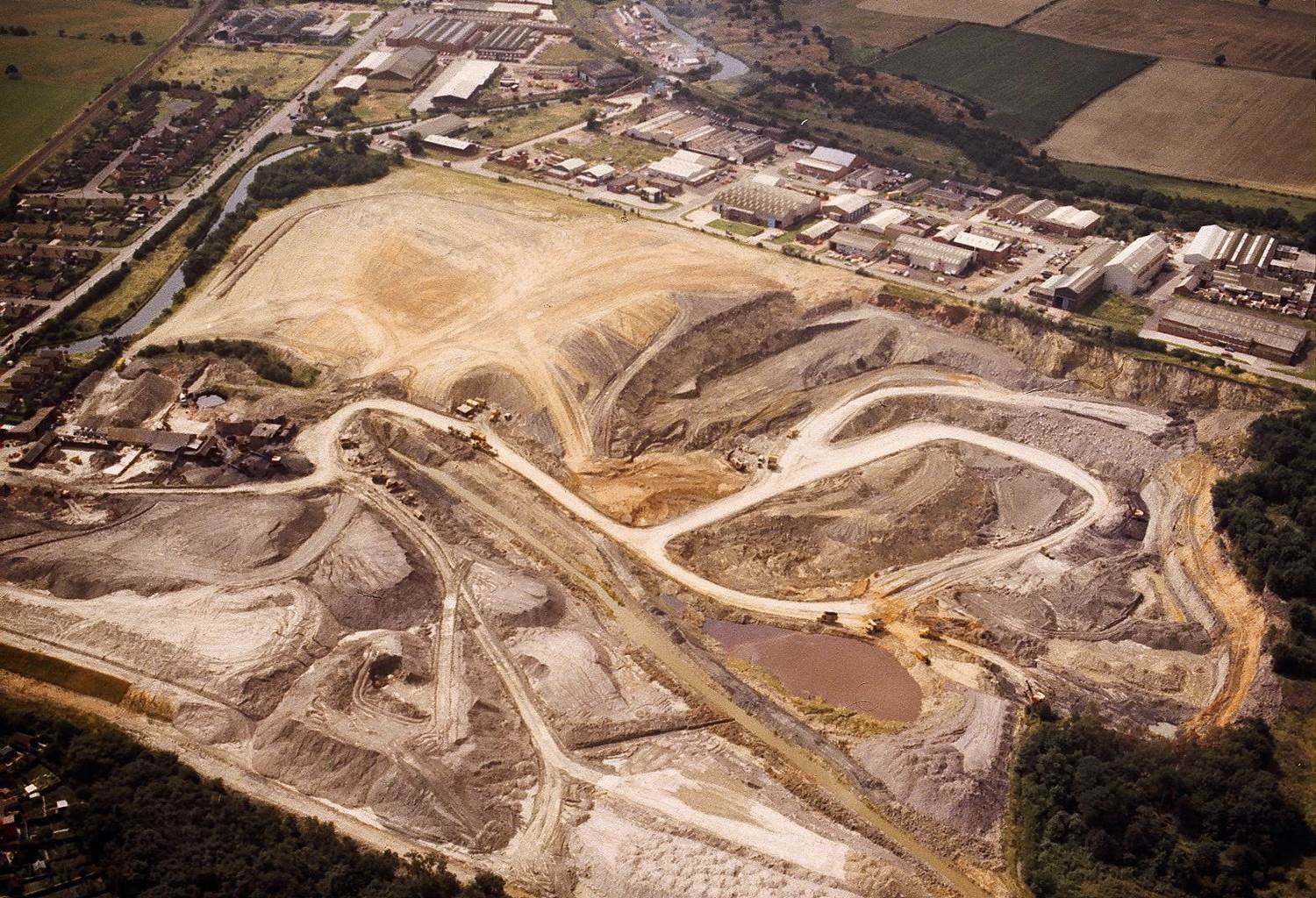Clay
Leading Suppliers
Potclays has been renowned as a leading supplier of clay for almost 90 years. Most of these clays are based upon the unique deposits taken from our clay mines at Brownhills, South Staffordshire (image on the right shows an aerial view of our mine in the 1970's - click to zoom). In the last 50 years we substantially increased our manufacturing capabilities to include the manufacture of a comprehensive range of glazes and a wide range of top quality kilns of both electric and gas fire types.
Our product range is extensive but we are also able to produce clays, glazes and kilns to customers' specifications. Our products are intended for potters, sculptors, tilemakers and ceramists in craft, education and industry. We aim to bring together a combination of our own manufactured products with a selection of other respected brand names throughout the world. We provide comprehensive technical data allowing easier selection of the product most suitable for a particular application.
We endeavour to cater for all skill levels: For the expert user, we offer a wide range of clays, glazes, colours etc. suitable for use in advanced techniques and capable of giving superb results. On the other hand, we appreciate many of our customers are new to ceramics so we provide resources and technical advice to assist in the choice of materials, equipment and making methods. You are always welcome to visit us at our showrooms in Etruria, Stoke-on-Trent, to browse and collect any supplies you may need. Please check our Contact page before making a special journey, and call in advance of your visit to check stock availability.
Read our sustainability policy here>
Selecting Clays
All of our own-manufactured clay bodies are in plastic form, packed in 12.5kg packs. We always recommend that our clays are kneaded and wedged before use for optimum results. When stored in a cool but frost-free situation, free from draughts and direct sunlight, the clay packs will retain their condition almost indefinitely. Sunlight can cause a green algae growth on the surface of the clay which is harmless and will burn away in the firing. In fact many believe the presence of mould is an indicator of the "souring" process which improves the plasticity.
For general use, we recommend 150-1102 Oxidising St Thomas and 151-1124 Sanded Buff bodies, both of which are slightly grogged. If a smooth clay is preferred then we suggest clays 159-1132A New Keuper Red, 159-1135 Original Red S/E, 159-1137 Red Earthenware Terracotta, 151-1120 Buff School Clay or 158-1141 Studio White Earthenware. For more specialised needs, our selection chart can be viewed here. Some clays have very wide firing ranges, enabling them to be used for earthenware (1100-1150C), middle temp.(1180-1220C) or stoneware (1220-1300C). These include:
- Buff firing: 150-1102, 151-1120, 151-1124, 157-1150
- Red firing: 159-1132A, 159-3240A, 159-1134
- White firing: 158-1141, 158-4130
Glaze Suitability/Firing Temperatures
We recommend biscuit firing at 1000-1060C then following with a glaze firing to a higher temperature which matures both the clay and the glaze at the same time. Each clay body and each glaze is listed with its firing range. When selecting a glaze for use with a particular clay it is important to select one with a firing range which exceeds the lower figure given for the clay. If this is not done the clay will be underfired and the glaze consequently may craze. An alternative is to biscuit fire the clay above the lower figure given for the clay then glaze fire to the firing range of the selected glaze. This method may cause difficulty with glaze pick-up when dipping although this can be overcome with flocculant addition. Bone china is invariably produced this way.
Click here to download our clay selection chart>
Firing Rate
The optimum firing rate depends upon the thickness of the pots and clay type e.g. thin cast and grogged bodies can be fired more quickly than thrown and ungrogged ones. Ideally, biscuit firings would be slower than 100C per hour up to 200C and 100 - 200C per hour beyond that point and ending with a short soak. Glaze firings should be at 100-130C per hour but at 100C per hour maximum from 700-1100C with high carbon ball clay or fireclay based bodies.
The maximum firing temperature for each clay is approximately indicated by the vitrification point given in our Clay Analyses chart but, with stoneware, it will be lowered by reduction firing conditions and is dependent upon other factors such as firing cycle (heatwork). Consequently this figure is given only as a guide for comparison purposes. If clays are fired above their vitrification point then bloating is likely. Bloating may also result from insufficient biscuit firing or too fast firing in the later stages of the glost firing. Conversely, overlong firings may give excess heat work and cause bloating. We recommend the use of pyrometric cones to monitor firing performance.
Recipes of heavily grogged panmilled bodies 153-1114, 153-1153 and 154-1154 were amended in mid 1998 to give improved resistance to lime popping and efflorescence problems. These changes involved using new refractories instead of reclaimed firebrick as the grog source, finer processing of certain other clay constituents and the introduction of 153-3114 Premium Craft Crank. We now only use Hi Pur grogs and high quality sands in our clay production. Firing to a light grey-white colour and of exceptional purity, Hi-Pur grogs are virtually guaranteed lime-free. The carefully graded material allows the coarsest of clay blends to be prepared with complete peace of mind and with the confidence that there will be no nasty surprises from impurities.
Manufacturing Methods
Bodies marked with a 'P' are finished by our Panmilling technique. This production method gives excellent, reliable control of grog and water contents but is inherently more open to occasional larger or extraneous particles arising in the ingredients or during processing. It generally produces better moisture control in grogged bodies.
Bodies marked with an 'S' are Sliphoused bodies. These are prepared in very large batches in slip form which is finely sieved prior to or after grog addition. The purified slip is then pumped into presses for dewatering prior to pugging. Sliphousing gives greater product uniformity and virtually guarantees freedom from contamination, but it is more difficult to control grog contents due to settling from suspension, and moisture content. It is the best technique for smooth-textured bodies.
Bodies marked with a 'PB' are produced by a Plastic Blending process, which yields bodies offering the high purity and cost effectiveness of a sliphoused product together with the ultra-tight control over grog additions offered by the panmilling process.
Air Hardening Clay
165-1187 Creative Clay™Grey and 165-1188 Creative Clay™ Red are air-drying clays we developed using the highest quality materials available. Essentially a standard potters' modelling clay with an addition of nylon fibres to provide exceptional bonded strength when dry and unfired. These nylon reinforcing fibres are an excellent bonding agent which reduces brittleness and means that the clay need not be fired. It is an ideal modelling medium for both children and adults, and can be painted and/or varnished once dry. Creative Clay can also be thrown, moulded etc. For more durable pieces, the clay can be fired and glazes applied. The firing range of Creative Clay™is 1000C to 1280C for the grey version and 1050C to 1170C for the red.
Casting Slips
Our casting slips are prepared to a specific gravity of 1.7 - 1.8 ( 34 - 36ozs per pint). They are supplied in plastic jerry cans which we have found withstand couriers' harsh handling processes more reliably than lidded buckets. They are correctly deflocculated ready for use but in certain circumstances it may be desirable to thin them slightly, in which case add just a few drops of Sodium Dispex per gallon and mix thoroughly. We recommend using a mixer attachment on an electric drill.
Casting Slips are produced by adding about 0.25% - 0.5% of deflocculant with water to powdered or plastic clay. Over-addition of deflocculant causes cracking and sticking of casts on the mould. Under-addition is sometimes desirable but causes slips to thicken on standing, although they will thin again on stirring (thixotropic). Sodium Silicate and Soda Ash are the usual deflocculants but we strongly recommend Sodium Dispex for topping-up addition and slip adjustment.
Coloured Decorating Slips
These are clay-water slips for dipping and trailing in the manner of traditional slipware. Compounded from earthenware bodies but capable of firing to stoneware. Water may be added or removed to alter the consistency. Under certain conditions, dilution may be desirable to avoid flaking.
Credit to: Izzy Letty izzylettyceramics.com




